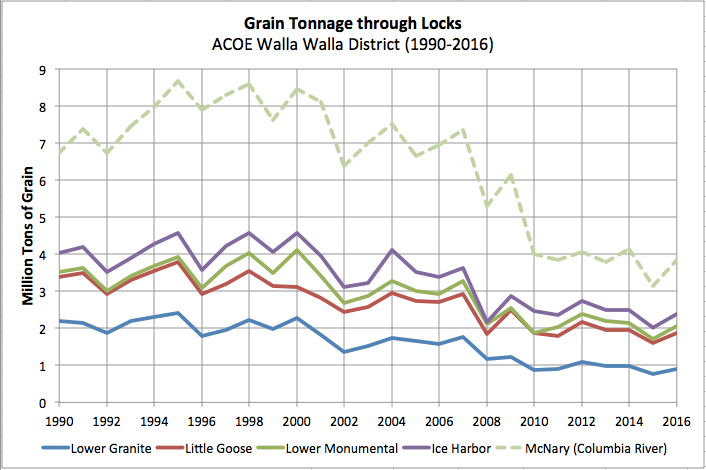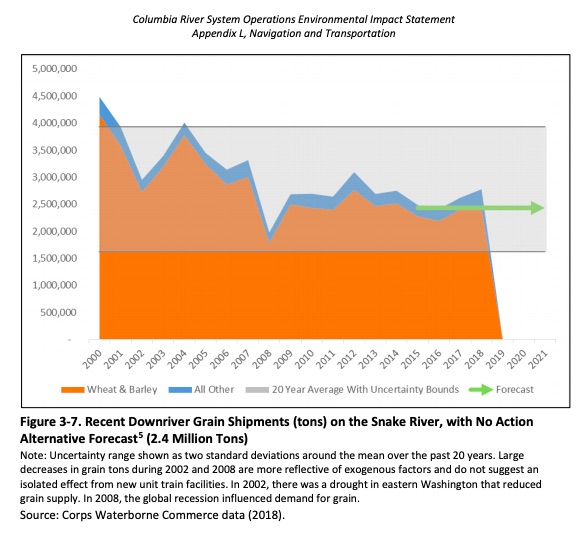forum
library
tutorial
contact

Industry: Wheat Export Costs Would Jump
Without Snake River Dams, Barges
by Matthew Weaver
Capital Press, June 14, 2023
|
the film forum library tutorial contact |

|
Industry: Wheat Export Costs Would Jump
by Matthew Weaver
|
 The cost of exporting wheat from inland elevators would increase "dramatically" if the lower Snake River dams are breached, preventing the use of barges, industry leaders say.
The cost of exporting wheat from inland elevators would increase "dramatically" if the lower Snake River dams are breached, preventing the use of barges, industry leaders say.
The impact of removing the dams would be "significant" for overseas customers, said Britany Hurst Marchant, executive director of the Idaho Wheat Commission.
"The price of wheat would increase because the price of freight would increase and those costs have to be offset somehow," she said.
The status of the Columbia-Snake river system and the impacts on transportation costs have been a topic that trade teams have brought up independently, said Amanda Hoey, Oregon Wheat CEO.
Barges are the cheapest way to transport wheat from farm to port. Removing the four lower Snake River dams would eliminate barging, Hurst Marchant said.
Doing so would translate into an additional 413 truck trips per day on Pacific Northwest highways, she said, citing a study by the Texas A&M Transportation Institute.
"An alternative infrastructure that could accommodate that much traffic increase simply does not exist," she said.
About 60% of wheat grown in Washington is transported by barge, said Casey Chumrau, executive director of the Washington Grain Commission.
"Rail infrastructure doesn’t exist in most of the wheat-growing country that relies on the river," she said.
Environmentally, barges produce 10% of the carbon per ton-mile of cargo compared to trucks, "so it would be a tremendous increase in carbon emissions through the Snake River corridor," she said.
About 60% of all exported U.S. wheat is loaded at Pacific Northwest export elevators, said Steve Mercer, vice president of communications for U.S. Wheat Associates, the overseas marketing arm for the industry. Most soft white wheat exports are barged to those elevators.
The Snake River moves more than 10% of all wheat exported from the U.S.
"While it is impossible to speculate about the impact on export prices, it is safe to say that transportation costs would dramatically increase to move the same amount of soft white," Mercer said.
Buyers overseas regularly tell Hurst Marchant that wheat from the Pacific Northwest is not the cheapest, but it is the most reliable in delivery.
"Because of the river system and our barging infrastructure, we can dependably get wheat from our farms to our buyers year-round," Hurst Marchant said. "For countries that do not have the climate or the geography to store much wheat, it is imperative that they receive wheat on time to keep up with consumer demand."
Removing the dams would present "serious economic challenges" to the 95% of farms that are family-owned in Washington, Chumrau said.
"With significant increases in production costs over the last two years given supply chain issues, higher input costs and inflation all chipping away at the profitability of wheat production, the dams are as important as ever," she said.
The Idaho Wheat Commission produced the video story above about the Columbia Snake River System and its irreplaceable role in the Pacific Northwest U.S. wheat production and export system.

learn more on topics covered in the film
see the video
read the script
learn the songs
discussion forum
